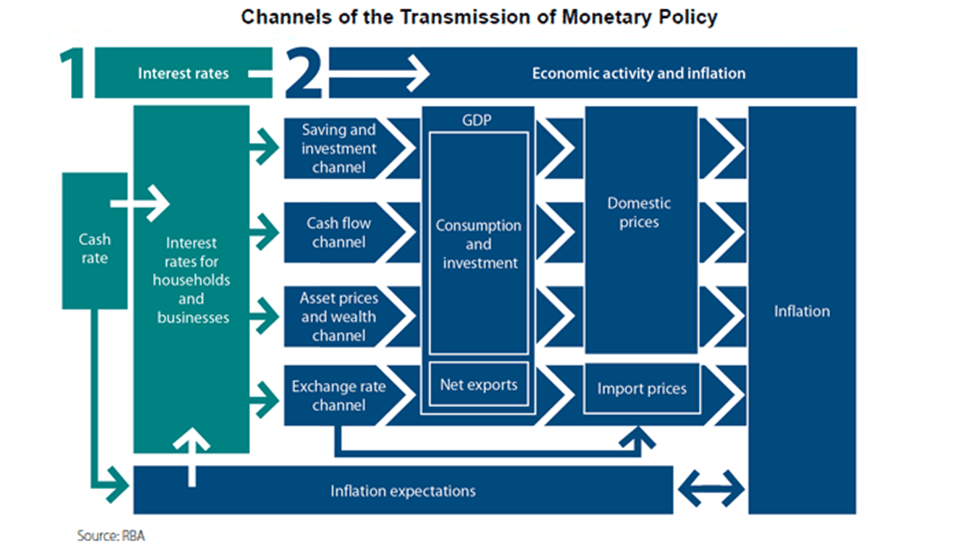Australia has experienced strong economic growth following the COVID-related weakness of 2020. However, this growth, accompanied by supply chain disruption, political changes and the war in Ukraine, is leading to upward pressure on prices for resources, food, and other commodities and an increase in inflation.
Inflation usually makes it harder for companies to grow earnings because inputs and labour are more expensive and consumer confidence decreases due to wage stagnation and increased cost-of-living expenses.
Consumer prices in Australia are rising at an annual rate of 6.1 per cent; consequently, the Reserve Bank of Australia (RBA) is increasing rates to try and dampen inflation.

The effects of increasing interest rates can be complex and vary over time. As it’s impossible to know exactly how long these effects take to play out or how large they will be, businesses need to be across the variety of ways changes to interest rates influence economic activity and their business.
According to the RBA, the transmission of monetary policy happens in two stages:
- Changes to the cash rate affect other interest rates in the economy
- Changes in these interest rates affect economic activity and inflation.
The first stage is where ‘interest rate pass-through’ occurs and changes to the cash flow rate flows through to other interest rates, other factors affecting interest rate pass-through include financial markets, changes in competition, and loan risk.
The second stage of transmission refers to how interest rate changes influence economic activity, employment and inflation. This occurs through a range of channels, including:
- Savings and investments
- Cash flow
- Asset prices and wealth, and
- Exchange rates

How could rising interest rates affect my business?
There are several ways a hike in interest rates can affect your business, including:
- Reduced borrowing power — Higher interest rates can make banks less willing to loan large amounts to businesses.
- Higher loan repayments — Higher interest rates mean a higher percentage of your loan payment will only pay the interest on the loan rather than the loan itself, extending the life of the loan. Financially stretched businesses may move to interest-only payments.
- Lower consumer spending — Higher interest rates reduce disposable income as consumers use their cash to pay for loans. However, it also incentivises saving due to the interest earned.
- Reduced investment — Businesses may hesitate to take on new risks and purchases.
- Reduced profit margins — As interest rates rise, consumer spending decreases and materials costs increase, negatively impacting profit margins.

Protecting profit margins as interest rates rise
Determining the best way for your business to protect profit margins will depend on various factors, including your relationship with vendors, brand equity and pricing strategies; understanding your data will help you decide which is the best option. Options to consider include:
- Changes to pricing strategies — Businesses must evaluate pricing strategies, including leveraging or bundling existing goods and services or discounting upfront for prompt payments.
- Consider your supply chain — Overseas markets are volatile now, so consider finding a domestic supplier to ensure stability and reduce freight and storage costs. In addition, review procurement practices to ensure competitive bidding and that suppliers are accountable for justifying price increases.
- Review your workforce: The labour market is competitive. To keep talented staff, consider offering flexible work arrangements and looking for subsidised training and development opportunities.
- Improve productivity and efficiency — Review processes and outputs to improve or streamline your operations, and look at automation, including business software.
- Strategically cutting costs — Review your current service providers and contracts, including telecommunications and internet providers, commercial property leases and service contracts. Avoid reducing marketing spend, which could cost you business in the long term.
- Revisit your banking and financial products needs — Look beyond your short-term needs and ensure that the interest rate on your business loans is competitive and weigh the benefits of variable and fixed rates. In addition, review the interest on your savings accounts and ensure your institution is giving you a competitive rate of return.
- Update incentive systems — Ensure the incentive systems for sales and procurement teams are focused on protecting gross margin.
- Build a dedicated team — Build a dedicated team to oversee planning and strategy on how to guide the business through increases in interest rates and inflation.
Changes to interest rates present challenges and opportunities for any business. However, understanding how these changes affect the economy can help you better identify which strategy you need to best protect your business.
While business environments remain uncertain, owners and managers should ‘expect the unexpected’ and make decisions based on solid strategies and seek advice when needed.
Beyond Advisors offers professional advice for businesses of all shapes and sizes. For any help or assistance in navigating uncertain times and rising interest rates, you can get in touch with our helpful team.